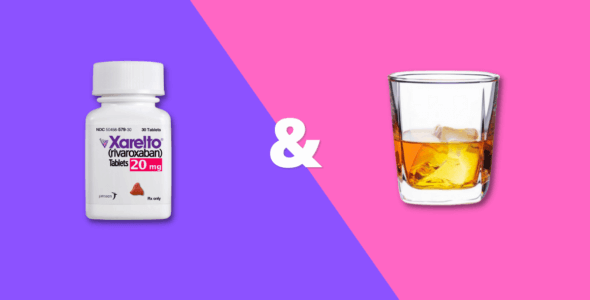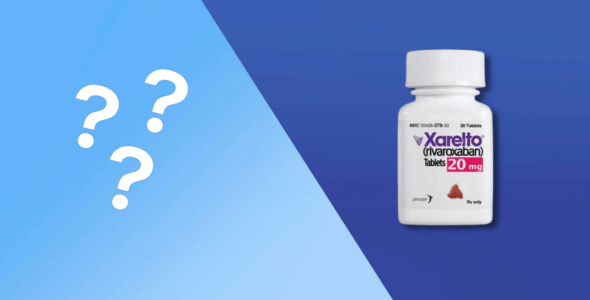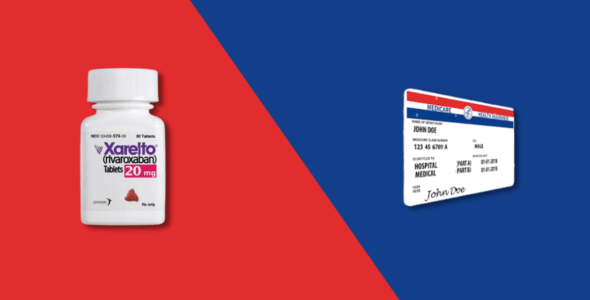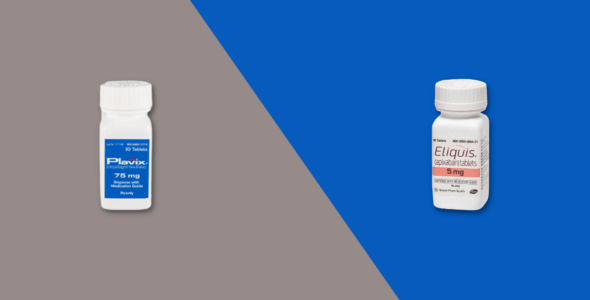Plavix and Xarelto are brand names for blood thinners used to prevent blood clots. Both are prescription drugs approved by the FDA used for preventing strokes, heart attacks, and death in individuals who have had a previous stroke, unstable angina, heart attack, or have peripheral arterial disease (PAD). Many patients prefer drugs like Plavix and Xarelto, in place of warfarin (Coumadin), which is particularly difficult to manage due to regular blood tests and monitoring intake of vitamin K.
Plavix and Xarelto are both blood-thinning medications that work in different ways to achieve their effect. To help, here we explain clearly and simply what Plavix and Xarelto are, how they work, the similarities and differences between them and their side effects, and more. This should provide you with the basics to better understand your options.
What is Xarelto?
Xarelto contains the active ingredient rivaroxaban. It is a direct-acting oral anticoagulant that works by blocking factor Xa, a fundamental component in the clotting process.
Xarelto is indicated for the following conditions:
- Reduce the risk of stroke and systemic embolism in patients with nonvalvular atrial fibrillation (AFib, or irregular heartbeat)
- Prevent deep vein thrombosis (DVT) in the legs and pulmonary embolism (PE) in the lungs of patients who have had hip or knee replacement surgery
- Treatment of deep vein thrombosis (DVT)
- Treatment of pulmonary embolism (PE)
- Reduce the risk of blood clots happening again in people who continue to be at risk for DVT or PE after receiving treatment for blood clots for at least 6 months
- Prevention of DVT, which may lead to PE in patients undergoing knee or hip replacement surgery
- Prevention of blood clots in certain people hospitalized for an acute illness and after discharge, who are at risk of getting blood clots due to the loss of or reduced ability to move around, and other risks for getting blood clots, and who do not have a high risk of bleeding
Xarelto can also be used with aspirin to:
- Lower the risk of cardiovascular death, heart attack, and stroke in patients with chronic coronary artery disease (CAD) or peripheral artery disease (PAD)
- Reduce the risk of a serious reduction in blood flow to the legs, stroke, major amputation, and heart problems in patients with PAD (a condition where the blood flow to the legs is reduced)
How does Xarelto work?
When your blood clots, it goes through a chemical process that turns it from a liquid to a thick gel. This chemical process is complex and has a number of steps that happen in sequence. Rivaroxaban works by interrupting one of these steps.
When you take Xarelto, rivaroxaban is absorbed into your blood. It attaches itself to and blocks an enzyme in your blood, called Factor Xa. This enzyme controls a step in the clotting process, and by blocking it, rivaroxaban makes it less likely your blood will clot. Another factor Xa drug is Eliquis (apixaban).
How do you take Xarelto?
It comes in tablet form and is taken by mouth. Xarelto is available in four strengths: 2.5 mg, 10 mg, 15 mg, and 20 mg, and your dosage will vary by indication. Xarelto is manufactured by Janssen Pharmaceuticals.
What is Plavix?
Plavix is an antiplatelet drug that specifically inhibits the platelet P2Y12. It is approved by the U.S. Food and Drug Administration (FDA) for the treatment of:
- Acute coronary syndrome – reduces the high risk of myocardial infarction (MI) and ischemic stroke in patients with unstable angina
- Recent MI, recent stroke, or established peripheral arterial disease (PAD)
Plavix can also be used with aspirin to treat heart disease. Plavix contains the active ingredient clopidogrel, which is available as a generic medication.
How does Plavix work?
Plavix belongs to a class of drugs called platelet aggregation inhibitors. Your body uses platelets to help it form blood clots. By blocking the activity of platelets, drugs like Plavix help to prevent your body from making too many clots.
Having your body form blood clots is normally helpful, especially if you’re injured or bleeding. However, in other cases, blood clots can be dangerous.
When clots form inside blood vessels, they can block the flow of blood to your heart, lungs, brain, or anywhere else in your body. This can result in serious conditions such as a heart attack and stroke. Plavix works to prevent these conditions by helping prevent blood clots from forming. Other platelet P2Y12 inhibitor drugs are ticagrelor (Brilinta) and prasugrel (Effient).
How do you take Plavix?
Plavix comes as oral tablets. It’s available in two strengths: 75 mg and 300 mg. The Plavix dosage your doctor prescribes will depend on the type and severity of the condition you are using Plavix to treat.
Plavix and Xarelto and bleeding
Your blood forms clots to plug cuts and injuries, stopping you from bleeding. Because Plavix and Eliquis reduce blood clots, they can increase your risk of bleeding, which can be serious, or even fatal.
You should avoid taking other medications that increase your chances of bleeding with Plavix and Eliqiuis. These include aspirin and other antiplatelet agents, other anticoagulants such as heparin, selective serotonin reuptake inhibitors (SSRIs), antidepressants, serotonin-norepinephrine reuptake inhibitors (SNRIs), and nonsteroidal anti-inflammatory drugs (NSAIDs) like ibuprofen.
If you’re taking Plavix or Eliquis and you begin to bleed or you experience symptoms of blood loss, seek urgent medical attention.
Common side effects of Plavix and Xarelto
The most common side effects are related to bleeding for both Plavix and Xarelto, such as:
- Nosebleeds
- Bleeding gums
- Heavier menstrual bleeding
- Unexpected vaginal bleeding
Side effects of Plavix:
- Excessive tiredness
- Headache
- Dizziness
- Nausea
- Vomiting
- Stomach pain
- Diarrhea
Side effects of Xarelto:
- Muscle spasms
- Swelling or joint pain
- Headache
- Rash
- Chest pain or tightness
- Dizziness
Serious side effects that can sometimes occur when taking Plavix and Xarelto can include:
- Serious allergic reactions to the medication. Symptoms include hives, chest pain, and trouble breathing
- Bleeding in your brain and spinal column
- Bleeding in your lungs
- Bleeding into a muscle
- Unusual bleeding
- Vomiting blood that looks like coffee grounds
- Tarry stools
The increased risk of bleeding problems may on occasion turn into major bleeding, causing life-threatening results. Plavix and Xarelto can have side effects, although not everyone will experience them, or have the same ones. Most side effects caused by Plavix and Xarelto are related to increased bleeding, as the medication prevents clotting. Inform your doctor if you are on Plavix or Xarelto before you have any medical or dental procedures or surgery.
This isn’t a comprehensive list of all the side effects Plavix and Xarelto can cause. Side effects depend on the dose you’re taking and the condition you’re taking Plavix or Xarelto for. You can find more details on the side effects in the patient leaflet that comes with your medication.
If you have any concerns about Plavix or Xarelto side effects, talk to your physician, cardiologist, or a pharmacist for medical advice. Also inform your healthcare provider about any medical conditions, supplements, and over-the-counter meds you are taking. You are also encouraged to report side effects to the FDA: visit http://www.fda.gov/medwatch or call 1-800-FDA-1088.





